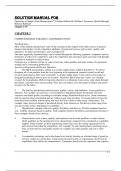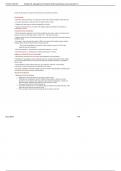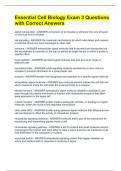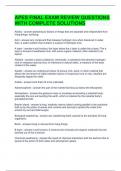Solution Manual for
Operations & Supply Chain Management 8th Canadian Edition By William J Stevenson, Hydeh Mottaghi,
Behrouz Bakhtiari
Chapter 1-18
CHAPTER 2
COMPETITIVENESS, STRATEGY, AND PRODUCTIVITY
Teaching Notes
Most of the students already know some of the concepts in this chapter (from other courses or general
business knowledge): (a) the competitive attributes of goods and services such as price, quality, and
timeliness, (b) plans and strategies, and (c) productivity.
The three apparently disjointed topics can be related through the following argument: companies must be
productive in order to be competitive, and to be competitive they must have goals and some well-thought-
out plans or strategies to achieve them.
Concepts new to students will be (a) value or best buy, order qualifies and order winners (b) operations
strategy and (c) measuring productivity.
Answers to Discussion and Review Questions
1. The IKEA sustainability strategy is a circular supply chain, as IKEA describes it, ―It‘s about
designing all of our products from the very beginning to be repurposed, repaired, reused, resold and
recycled, generating as little waste as possible. A circular supply chain "is one where every product is
designed and produced with its next use in mind". Therefore, IKEA treats the "waste" as a valuable
resource for its production. IKEA's long-term objective is to eliminate waste across value chain, through
prevention, reduction, reuse and recycling. Thus, they can reduce costs and negative impacts and secure
resources for the future.
2. The four key purchasing criteria are price, quality, variety, and timeliness. Every purchase is
different. For example, one may buy a very inexpensive Durabrand electric bread knife, but more
expensive and better quality (according to consumer ratings) Hamilton Beach mixer. Some consumers
look for special colours and models and are willing to pay more for them. Everyone prefers to have the
items they need available without delay, but some will wait a little in order to get a better price. For
example, many items are cheaper if purchased directly from Amazon.ca, but delivery times range from
one day to many weeks, depending on availability.
3. Organizations compete with cost, quality, flexibility, and delivery. WestJet competes based on
cost. Cadillac competes based on quality. Dell competes based on flexibility (customization). Domino‘s
Pizza competes based on fast delivery.
4. Characteristics such as price, quality, and timeliness can be order qualifiers or order winners.
Order qualifiers are the minimum level of characteristics required to be considered as a qualified
supplier. Order winners are those purchasing criteria that cause the selling organization to be
perceived as better than the competition. For example, for auto manufacturers operating just-in-
time, on-time delivery and quality of parts of a supplier are order qualifies and cost is order
winner.
5 A competitive advantage can be developed over time by focusing on a limited range of goods or
services, and/or on a technology. Using teamwork and rewards, an organization can develop its
capabilities (also called core competencies). Companies should use past experience and expertise
2-1
, in design, operations/manufacturing, or marketing, and leverage them to introduce new goods and
services.
6.
a) Interest rate on savings.
b) Interest rate on checking and CDs.
c) Loan rates.
d) Quick loan application processing.
e) No fees or low fee values (free checking, no or low ATM fees).
f) Number of branches and locations to make it more convenient for the customers.
g) Free on-line banking.
h) Extended hours of service.
i) Extra services.
j) Lower minimum deposit before charging a service fee.
7. The eleven strategic decision categories are: Product and service design, capacity, facility layout,
work design, location, quality, inventory, maintenance, scheduling, supply chains, and projects.
8. Strategy is the basic approach and a long-term plan used by an organization to achieve its goal
Tactics are the medium-term plans, methods and actions that are taken to accomplish strategies
and carry out operations.
9. Answers vary for each student.
Example of a policy for waiting staff: Respond to every customer request with ―my pleasure‖.
Example of an action plan: hire a design artist, buy a camera and plate making machine (in order
to reduce graphics production lead time from 10 days to 1 day)
10. An operations strategy comprises a set of well-coordinated policies, objectives, and action plans
for the operations function.
11. The formulation of an operations strategy involves the following steps: (a) determine the
operations requirements of the business strategy, (b) categorize customers and their competitive
priorities, (c) group product lines into types, (d) assess the strengths & weaknesses of the current
operations strategy and products, (e) assess the degree of focus in each plant, and (f) determine
the objectives, policies, and action programs in the nine strategic decision categories for product
lines and assign them to plants.
12. A time-based strategy focuses on reducing the time needed to conduct the various activities in
product design, production, and distribution. Examples include just-in-time (―made for you‖)
production by McDonald‘s and cellular layout by StandardAero.
13. Answers might vary for each student. Boeing was forecasting that demand for medium-to-long
range flights between medium-size cities will increase, whereas Airbus was forecasting that
demand for very long-range flights between major cities in Asia and North America, will
increase. For more info. see e.g., http://www.smarttravelasia.com/AirbusVsBoeing.htm.
2-2
,14. Strategic responsibilities in supply chain management include:
a. Supply chain strategy alignment: Aligning the supply and distribution strategies with the
organizational strategy and deciding on the degree to which outsourcing will be used.
b. Network configuration: Determining the number and location of suppliers, warehouses,
production/operations facilities, and distribution centers.
c. Information technology: Integrating systems and processes throughout the supply chain to
share information.
d. Products and services: Making decisions on new product and services selection and design.
e. Capacity planning: Assessing long-term capacity needs, including when and how much will
be needed and how much flexibility is required.
f. Strategic partnership: Partnership choices, level of partnership, and degree of formality.
g. Distribution strategy: Deciding whether to use centralized or decentralized distribution, and
deciding whether to use the organization‘s own facilities and equipment or to use 3PL
providers.
h. Uncertainty and risk reduction: Identifying potential sources of risk and deciding the amount
of risk that is acceptable.
Tactical responsibilities in supply chain management include:
a. Forecasting: Prepare and evaluate forecasts.
b. Sourcing: Choosing suppliers and some make-or-buy decisions.
c. Operations planning: Coordinate the external supply chain and internal operations.
d. Managing inventory: Decide where to store the various types of inventory.
e. Transportation planning: Match transportation capacity with demand.
f. Collaborating: Work with supply chain partners to coordinate plans.
Operational responsibilities in supply chain management include:
a. Scheduling: Short-term scheduling of operations and distribution.
b. Receiving: Management of inbound deliveries from suppliers.
c. Transforming: Conversion of inputs into outputs.
d. Order fulfilling: Linking production resources and/or inventory to customer orders.
e. Managing inventory: Maintenance and replenishment activities.
f. Shipping: Management of outbound deliveries to distribution centers or customers.
g. Information sharing: Exchange of information with supply chain partners.
h. Controlling: Control of quality, inventory, and other key variables, and implementing
corrective action when necessary.
15. A circular supply chain involves reusing, recycling, repurposing waste and customer returned
products into refurbished products or the manufacturing of new products to minimize the use of
raw materials. In a circular supply chain, waste is considered as new raw materials. Recycling
plastic into pellets to make new plastic products is an example of a circular supply chain, which
not only saves the raw materials and regenerates nature but also reduces CO2 emissions.
16. Nova Scotia Power combined the jobs of a meter reader, a meter installer (to replace broken
meters), and a bill collector (who could disconnect service because of overdue account). The new
job was called customer-service field representative (CSFR).
2-3
, 17. Productivity is a measure of productive use of resources, usually expressed as the ratio of output
to input. Productivity is important because it is related to profitability and standard of living.
18. Factors affecting productivity: method and management, equipment and technology, and labour.
An example of a method and management improving productivity is JIT (lean) production. An
example of equipment and technology improving productivity is computers and the Internet. An
example of labour improving productivity is trained and knowledgeable workers.
19. Efficiency is a narrower concept that means getting the most out of a fixed set of resources.
Productivity is a broader concept that means better use of overall resources. For example, an
efficiency perspective on mowing a lawn if given a hand mower would focus on the best way to
use the hand mower; a productivity perspective would include the possibility of using a power
mower.
20. The Japanese automakers such as Toyota and Honda are using more productive work methods,
such as lean production, than the Big 3 North American automakers (GM, Ford, Chrysler). Also,
they have better relations with their suppliers and workers.
21. Answers might vary for each student. ―If productivity increases, fewer workers will be needed‖ is
not necessarily true. For example, output can increase or other types of products can be
introduced. Even when the number of workers is reduced, the displaced workers can move to
other industries such as services.
22. The main reason that productivity measurement in health care is difficult is that measuring output
is difficult because it is partly intangible, involves intellectual activities, or the output has a high
degree of variability. One measure of output is quality-adjusted life years or life expectancy after
a patient has been diagnosed with a disease and then is treated or operated on. For example,
consider diabetes. Life expectancy depends on how early the patient goes to his/her doctor and on
performing some of the treatment personally (e.g., injecting insulin). If diagnosis is not done
early enough or is not managed well, diabetes can become serious and lead to other serious health
problems. In this case, the extent of deterioration in health due to diabetes may be hard to
measure. The involvement of patients and deterioration in health due to diabetes makes
measuring the productivity in diabetes healthcare difficult.
Answers to Taking Stock Questions
1. Top and senior management should be involved in formulating organizational strategy. However,
the opinions of middle and lower managers should also be sought.
2. Answers vary for each student. Competitive trade-offs that may arise in a fast-food restaurant
include:
product variety vs. speed of service: too many products will reduce the production speed
cost (staff wages) vs. speed of service: too few staff will increase wait times
3. a. Technology improves competitiveness by
reducing product cost/price (due to more efficient/automated processing)
increasing quality (e.g., automated quality control)
2-4







